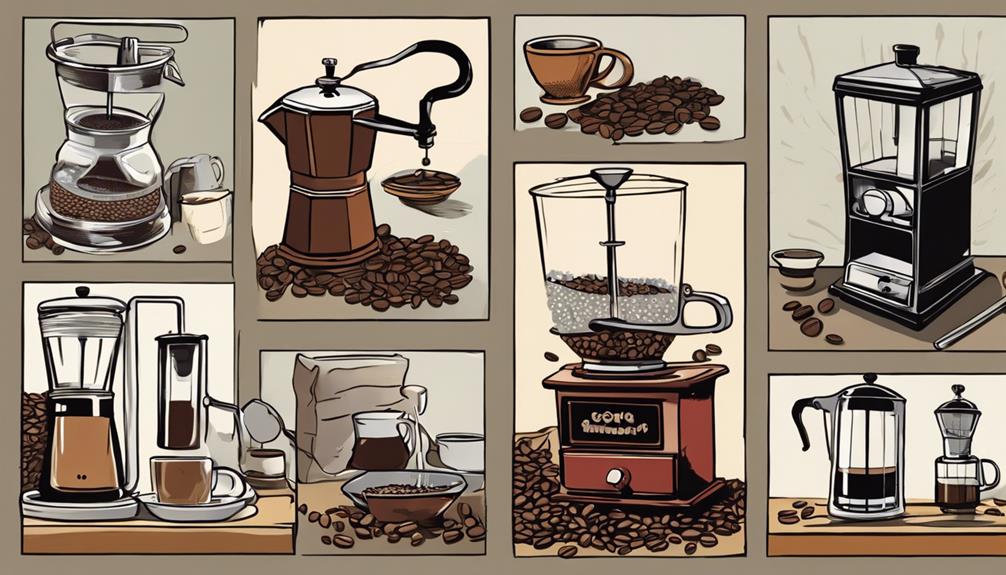For a bold cup of coffee, opt for dark roast beans such as French Roast to achieve a rich flavor profile. Grind the beans to the appropriate size for optimal extraction – aim for a medium grind when using flat-bottom filters. Enhance the taste by utilizing a drip maker with a metal filter. Find the right coffee-to-water ratio for a strong brew. Improve your brewing skills by ensuring a consistent grind size and adjusting the brew time to control the strength. Customize your brew by experimenting with different variables. To learn more about creating a flavorful coffee that caters to your preferences, delve into the details of bean selection, grinding methods, and various brewing techniques.
Key Takeaways
- Opt for dark roast beans for a stronger taste and higher caffeine content.
- Use a medium grind size for optimal flavor extraction.
- Experiment with different filters to control strength and taste.
- Maintain a coffee-to-water ratio of 1:15 to 1:17 for a bold brew.
- Adjust brewing variables like grind size, time, and temperature for customization.
Choosing Coffee Beans and Roast
When selecting coffee beans for brewing strong coffee, opt for dark roast varieties like French Roast or Italian Roast. Dark roast beans are ideal for a bolder flavor profile, as they undergo longer roasting times, resulting in a stronger taste with caramelized sugars.
For a unique coffee experience, consider single-origin beans from regions such as Sumatra or Papua New Guinea. These beans offer intense flavors that contribute to a robust brew.
To enhance the boldness of your coffee, look for brands like Death Wish Coffee or Black Insomnia, known for their high caffeine content and bold flavors. When purchasing coffee beans, pay attention to the roast date. Fresher beans provide more intense flavors, ensuring a strong and flavorful cup of coffee.
Grinding for Optimal Flavor Extraction

To extract the best flavor from your coffee beans, consider the impact of grind size on the brewing process.
- Grind size matters: Choosing the right grind size is essential for ideal flavor extraction. Opt for medium grind for flat-bottom filters and medium-fine for cone-shaped filters to achieve a balanced brew.
- Burr grinders for consistency: Invest in a burr grinder for a uniform grind size, ensuring uniform extraction and maximum flavor in every cup.
- Freshly ground is key: Freshly ground coffee beans preserve the richness and complexity of flavors better than pre-ground coffee, leading to a more flavorful experience.
Drip Coffee Maker and Filter Selection

Consider the type of filter that suits your preferences to enhance the taste and quality of your brewed coffee using a drip coffee maker. Filters play a pivotal role in the brewing process, as they help in trapping coffee grounds and allowing only the brewed coffee to flow through.
When choosing between paper filters and metal filters, keep in mind that paper filters can provide a cleaner cup by absorbing oils, resulting in a smoother final taste and mouthfeel. On the other hand, metal filters allow more oils to pass through, leading to a richer flavor profile.
The filter you select can impact the strength and clarity of the brewed coffee, ultimately influencing your overall coffee experience. Experiment with different filters to find what best suits your taste preferences and desired coffee outcome with regards to strength, clarity, final taste, and mouthfeel in each brewed cup.
Perfecting Coffee-to-Water Ratio

Achieving a strong coffee brew hinges on mastering the ideal coffee-to-water proportion, typically falling between 1:15 to 1:17 to suit your taste preferences.
To perfect your coffee-to-water proportion, consider the following:
- Use Accurate Measurements: Utilize a digital scale to ensure accurate measurements of both coffee and water, helping you achieve the perfect coffee-to-water proportion for a stronger brew.
- Adjusting the Proportion: Experiment with different coffee-to-water proportions to find the ideal one that suits your taste preferences and desired strength, as adjusting the proportion can greatly impact the flavor profile of your coffee.
- Bold Flavor Profile: Maintaining the correct coffee-to-water proportion is essential for achieving a bold and robust flavor profile in your brewed coffee, making it important to find the perfect balance for a strong cup of joe.
Mastering Brewing Techniques

Adjusting variables like coffee amount, grind size, and brew time allows you to master brewing techniques and customize the strength of your coffee to suit your preferences. To achieve a flavorful cup of coffee, consider experimenting with different brewing methods and making adjustments to your unique brewing process. Consistent grind size is essential for proper extraction, as finer grounds lead to a bolder flavor profile. Increasing brew time slightly can improve extraction without sacrificing taste, providing a more robust coffee strength. Additionally, selecting the appropriate water temperature and roast level can further influence the boldness of your brew.
| Brewing Techniques | Impact |
|---|---|
| Consistent Grind Size | Ensures proper extraction for a flavorsome cup of coffee |
| Brew Time | Adjusting slightly can boost coffee strength without compromising taste |
| Water Temperature | Influences the richness of the brew |
| Roast Level | Affects the overall potency and flavor profile of the coffee |
Frequently Asked Questions
How to Make Extremely Strong Coffee?
To make extremely strong coffee, use a coffee-to-water ratio of 1:8 or 1:10. Experiment with longer steeping times and dark roast beans for boldness. Try a French press or cold brew method for intense extraction. Adjust grind size finer for potency.
What Brewing Method Makes the Strongest Coffee?
For the strongest coffee, try the espresso brewing method. Its high concentration of coffee solids delivers a powerful kick. For bold flavor, the French press lets oils and fine particles into the brew.
How to Make Stronger V60 Coffee?
To make stronger V60 coffee, adjust the grind size finer, increase coffee-to-water ratio, extend brew time slightly, try bold coffee beans, and refine pouring technique. Elevate your brew by enhancing extraction for a robust flavor.
How to Make Coffee More Bold?
To make your coffee more bold, try using a higher coffee-to-water ratio, experimenting with dark roast beans, opting for methods like French press, extending steeping time, and adjusting grind size to be finer. Enjoy your bolder brew! For an even bolder flavor, try adding a splash of heavy cream or frothing your milk to create a rich and creamy texture. You can also sprinkle a pinch of cinnamon or cocoa powder on top for an added depth of flavor. Once you’ve perfected your bolder brew, sit back and savor each sip of your frothy coffee with spoon.
Conclusion
Now that you've learned the secrets to brewing a bold and strong coffee, you'll never go back to weak and watery cups again.
Like a warrior preparing for battle, armed with the perfect blend of beans and precise brewing techniques, you'll conquer each morning with a powerful and flavorful cup of coffee in hand.
So go forth and brew with confidence, knowing you have the skills to create the perfect pick-me-up every time.









